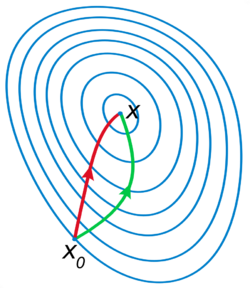📖 Fundamentals of optimization#
⏱ | words
The goal is Weierstrass extreme value theorem which establishes the existence of max and min for continuous functions over compact sets
Talk about sets in \(\mathbb{R}\) first \(\rightarrow\) then transitions to functions
In the introductory lecture we have seen a few simple examples of optimization problems:
a solution exists
the solution is unique and not hard to find
However, for the majority of problems such properties aren’t guaranteed
We need some idea of how to check whether a solution to an optimization problems even exists!
Consider the problem of finding the “maximum” or “minimum” of a function
A first issue is that such values might not be well defined
Recall that the set of maximizers/minimizers can be
empty
a singleton (contains one element)
infinite (contains infinitely many elements)
Show code cell content
from myst_nb import glue
import matplotlib.pyplot as plt
import numpy as np
def subplots():
"Custom subplots with axes through the origin"
fig, ax = plt.subplots()
# Set the axes through the origin
for spine in ['left', 'bottom']:
ax.spines[spine].set_position('zero')
for spine in ['right', 'top']:
ax.spines[spine].set_color('none')
return fig, ax
xmin, xmax = 0, 1
xgrid1 = np.linspace(xmin, xmax, 100)
xgrid2 = np.linspace(xmax, 2, 10)
fig, ax = subplots()
ax.set_ylim(0, 1.1)
ax.set_xlim(-0.0, 2)
func_string = r'$f(x) = x^2$ if $x < 1$ else $f(x) = 0.5$'
ax.plot(xgrid1, xgrid1**2, 'b-', lw=3, label=func_string)
ax.plot(xgrid2, -0.25 * xgrid2 + 0.5, 'b-', lw=3)
ax.plot(xgrid1[-1], xgrid1[-1]**2, marker='o', markerfacecolor='white', markeredgewidth=2, markersize=6, color='b')
ax.plot(xgrid2[0], -0.25 * xgrid2[0] + 0.5, marker='.', markerfacecolor='b', markeredgewidth=2, markersize=10, color='b')
glue("fig_none", fig, display=False)
Example: no maximizers
The following function has no maximizers on \([0, 2]\)
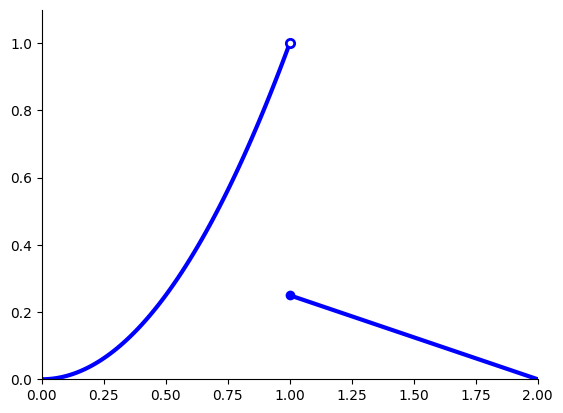
No maximizer on \([0, 2]\)#
Suprema and Infima (\(\mathrm{sup}\) + \(\mathrm{inf}\))#
Always well defined
Agree with max and min when the latter exist
Definition
Let \(A \subset \mathbb{R}\) (we restrict attention to subsets of real line for now)
A number \(u \in \mathbb{R}\) is called an upper bound of \(A\) if
Example
If \(A = (0, 1)\) then 10 is an upper bound of \(A\) — indeed, every element of \((0, 1)\) is \(\leqslant 10\)
If \(A = (0, 1)\) then 1 is an upper bound of \(A\) — indeed, every element of \((0, 1)\) is \(\leqslant 1\)
If \(A = (0, 1)\) then \(0.75\) is not an upper bound of \(A\)
Definition
Let \(U(A)\) denote set of all upper bounds of \(A\).
A set \(A \subset \mathbb{R}\) is called bounded above if \(U(A)\) is not empty
Examples
If \(A = [0, 1]\), then \(U(A) = [1, \infty)\)
If \(A = (0, 1)\), then \(U(A) = [1, \infty)\)
If \(A = (0, 1) \cup (2, 3)\), then \(U(A) = [3, \infty)\)
If \(A = \mathbb{N}\), then \(U(A) = \varnothing\)
Definition
The least upper bound \(s\) of \(A\) is called supremum of \(A\), denoted \(s=\sup A\), i.e.
Example
If \(A = (0, 1]\), then \(U(A) = [1, \infty)\), so \(\sup A = 1\)
If \(A = (0, 1)\), then \(U(A) = [1, \infty)\), so \(\sup A = 1\)
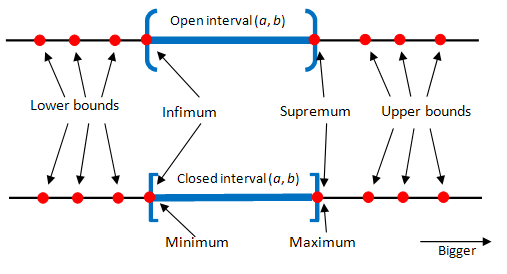
Upper and lower bounds, supremum and infimum of an interval on \(\mathbb{R}\)#
Definition
A lower bound of \(A \subset \mathbb{R}\) is any \(\ell \in \mathbb{R}\) such that \(\ell \leqslant a\) for all \(a \in A\).
Let \(L(A)\) denote set of all lower bounds of \(A\).
A set \(A \subset \mathbb{R}\) is called bounded below if \(L(A)\) is not empty.
The highest of the lower bounds \(p\) is called the infimum of \(A\), denoted \(p=\inf A\), i.e.
Example
If \(A = [0, 1]\), then \(\inf A = 0\)
If \(A = (0, 1)\), then \(\inf A = 0\)
Some useful facts#
Fact
Boundedness of a subset of the set of real numbers is equivalent to it being bounded above and below.
Proof
The proof follows trivially from the definitions
Fact
Every nonempty subset of \(\mathbb{R}\) bounded above has a supremum in \(\mathbb{R}\)
Every nonempty subset of \(\mathbb{R}\) bounded below has an infimum in \(\mathbb{R}\)
Proof
Similar to the proof that all Cauchy sequences converge, follows from the density property of \(\mathbb{R}\)
Some textbooks allow all sets to have a supremum and infimum, even if they are not bounded. This is achieved by extending the set of real numbers with \(\{-\infty,\infty\}\)
Then, if \(A\) is unbounded above then \(\sup A = \infty\), and if \(A\) is unbounded below then \(\inf A = -\infty\).
Note
Aside: Conventions for dealing with symbols “\(\infty\)’’ and “\(-\infty\)” If \(a \in \mathbb{R}\), then
\(a + \infty = \infty\)
\(a - \infty = -\infty\)
\(a \times \infty = \infty\) if \(a \ne 0\), \(0 \times \infty = 0\)
\(-\infty < a < \infty\)
\(\infty + \infty = \infty\)
\(-\infty - \infty = -\infty\) But \(\infty - \infty\) is not defined
Fact
Let \(A\) be any set bounded above and let \(s = \sup A\). There exists a sequence \(\{x_n\}\) in \(A\) with \(x_n \to s\).
Analogously, if \(A\) is bounded below and \(p = \inf A\), then there exists a sequence \(\{x_n\}\) in \(A\) with \(x_n \to p\).
Proof
Note that

(Otherwise \(s\) is not a sup, because \(s-\frac{1}{n}\) is a smaller upper bound)
The sequence \(\{x_n\}\) lies in \(A\) and converges to \(s\).
The proof for the infimum is analogous.
Maxima and Minima (\(\max\) + \(\min\))#
Definition
We call \(a^*\) the maximum of \(A \subset \mathbb{R}\), denoted \(a^* = \max A\), if
We call \(a^*\) the minimum of \(A \subset \mathbb{R}\) and write \(a^* = \min A\) if
Example
For \(A = [0, 1]\) \(\max A = 1\) and \(\min A = 0\)
Relationship between max/min and sup/inf#
Fact
Let \(A\) be any subset of \(\mathbb{R}\)
If \(\sup A \in A\), then \(\max A\) exists and \(\max A = \sup A\)
If \(\inf A \in A\), then \(\min A\) exists and \(\min A = \inf A\)
In other words, when max and min exist they agree with sup and inf
Proof
Proof of case 1: Let \(a^* = \sup A\) and suppose \(a^* \in A\)
We want to show that \(\max A = a^*\)
Since \(a^* \in A\), we need only show that \(a \leqslant a^*\) for all \(a \in A\)
This follows from \(a^* = \sup A\), which implies \(a^* \in U(A)\)
Fact
If \(F \subset \mathbb{R}\) is a closed and bounded, then \(\max F\) and \(\min F\) both exist
Proof
Proof for the max case:
Since \(F\) is bounded,
\(\sup F\) exists
\(\exists\) a sequence \(\{x_n\} \subset F\) with \(x_n \to \sup F\)
Since \(F\) is closed, this implies that \(\sup F \in F\)
Hence \(\max F\) exists and \(\max F = \sup F\)
Segway to functions#
Of course, in optimization we are mainly interested in maximizing and minimizing functions
Will apply the notions of supremum and infimum, minimum and maximum to the range of a function
Equivalently, we may consider the image of a set \(X \subset \mathbb{R}^N\) under a function \(f\)
Definition
Let \(f \colon A \to \mathbb{R}\), where \(A\) is any set
The supremum of \(f\) on \(A\) is defined as
The infimum of \(f\) on \(A\) is defined as
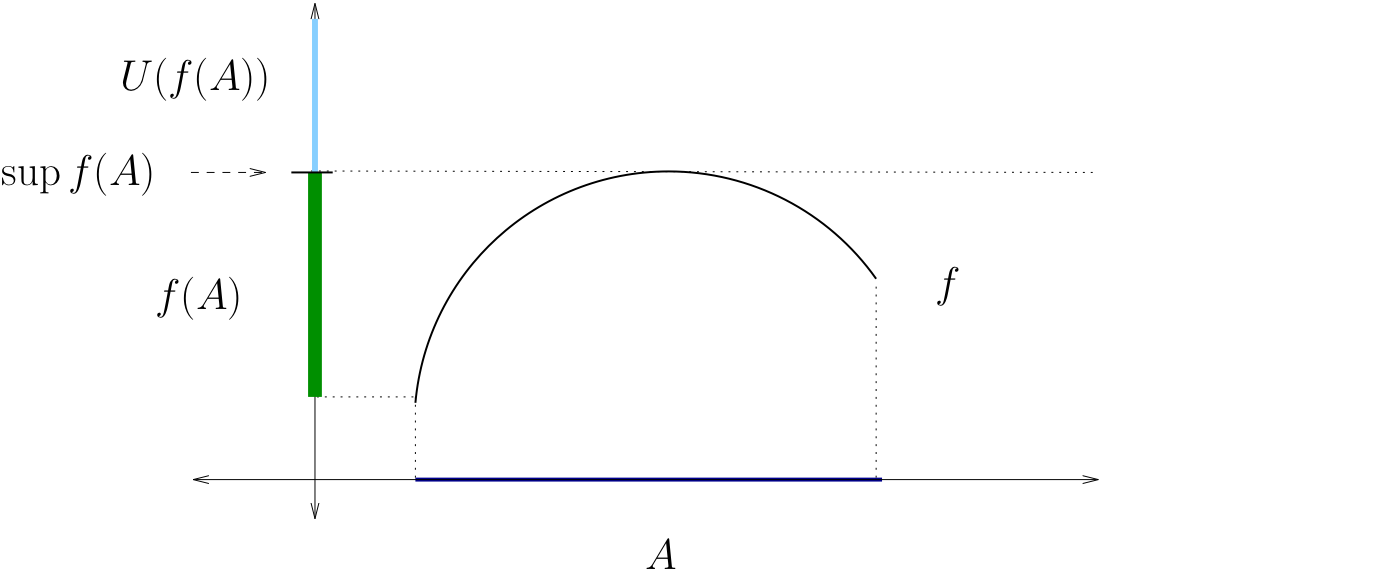
The supremum of \(f\) on \(A\)#
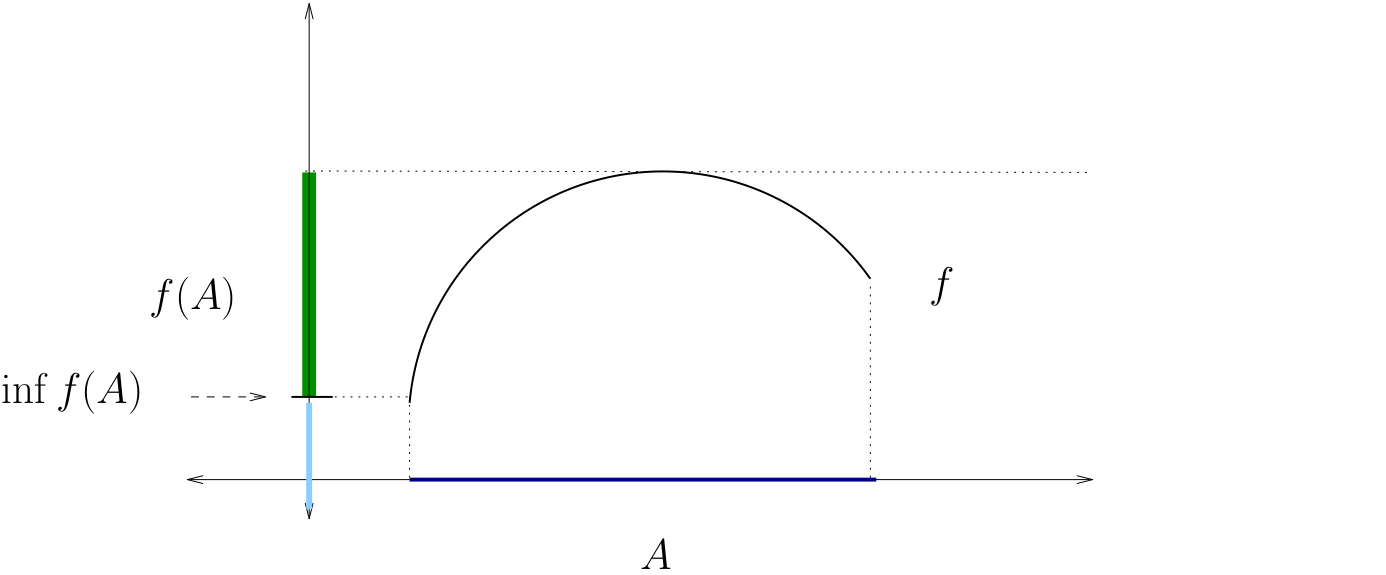
The infimum of \(f\) on \(A\)#
Definition
Let \(f \colon A \to \mathbb{R}\) where \(A\) is any set
The maximum of \(f\) on \(A\) is defined as
The minimum of \(f\) on \(A\) is defined as
$$
Definition
A maximizer of \(f\) on \(A\) is a point \(a^* \in A\) such that
The set of all maximizers is typically denoted by
Definition
A minimizer of \(f\) on \(A\) is a point \(a^* \in A\) such that
The set of all minimizers is typically denoted by
Weierstrass extreme value theorem#
Fundamental result on existence of maxima and minima of functions!
Fact (Weierstrass extreme value theorem)
If \(f: A \subset \mathbb{R}^N \to \mathbb{R}\)
is continuous and \(A\) is closed and bounded,
then \(f\) has both a maximizer and a minimizer on \(A\).
Proof
Sketch of the proof:
If \(f\) is continuous and \(A\) is compact, then \(f(A)\) is bounded, see relevant fact
Because \(f(A)\) is bounded \(\sup f(A)\) and \(\inf f(A)\) exist, see relevant fact
There is a sequence \(\{y_n\} \in f(A)\) converging to sup/inf, see relevant fact
Consider the corresponding sequence of \(x\) such that \(y=f(x)\)
It may not be convergent, but is bounded (belongs to compact), therefore contains a convergent subsequence (by Bolzano-Weierstrass theorem), see relevant fact
Let \(c\) be the limit of a convergent subsequence
Then by definition of continuity \(f(c)\) is the limit of the sequence \(f(x_n)\)
\(f(c)\) must then be the same as the limit of the sequence \(y_n\) = sup/inf due to the fact that any sequence can have at most one limit, see relevant fact
Therefore sup/inf is attained at \(x=c\)
Example
Consider the problem
where
\(r=\) interest rate, \(w=\) wealth, \(\beta=\) discount factor
all parameters \(> 0\)
Let \(B\) be all \((c_1, c_2)\) satisfying the constraint
Exercise: Show that the budget set \(B\) is a closed, bounded subset of \(\mathbb{R}^2\)
Exercise: Show that \(U\) is continuous on \(B\)
We conclude that a maximizer exists
References and further reading#
References
Simon & Blume: 12.2, 12.3, 12.4, 12.5, 13.4, 29.2, 30.1
Sundaram: 1.2.6, 1.2.7, 1.2.8, 1.2.9, 1.2.10, 1.4.1, section 3
